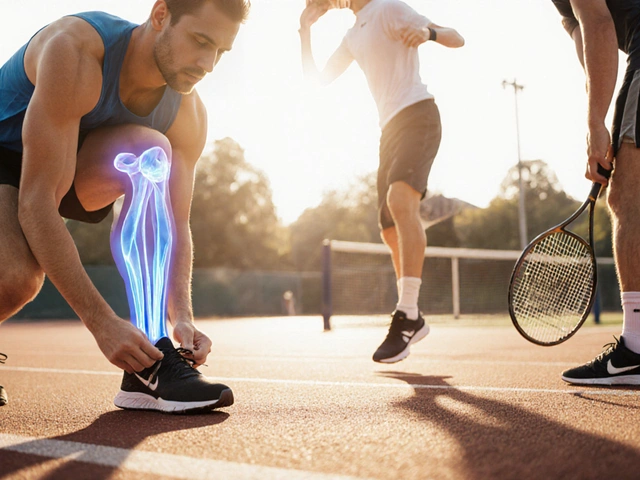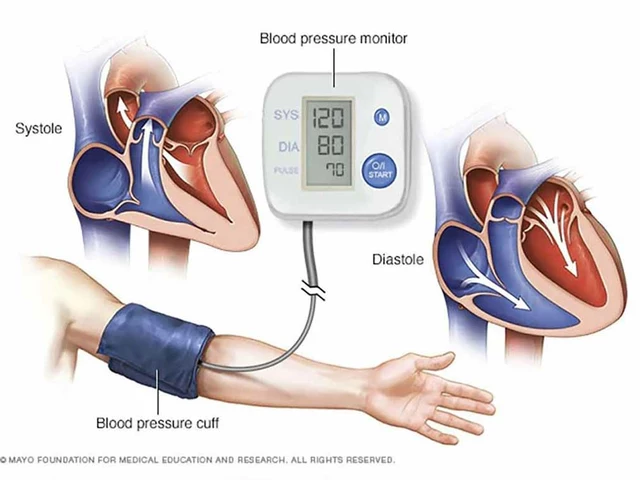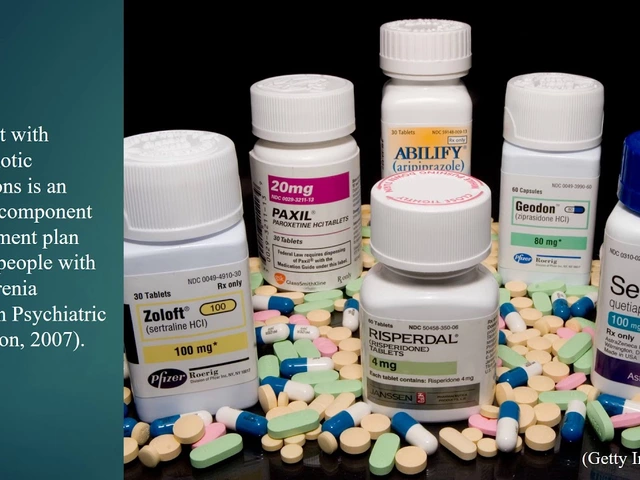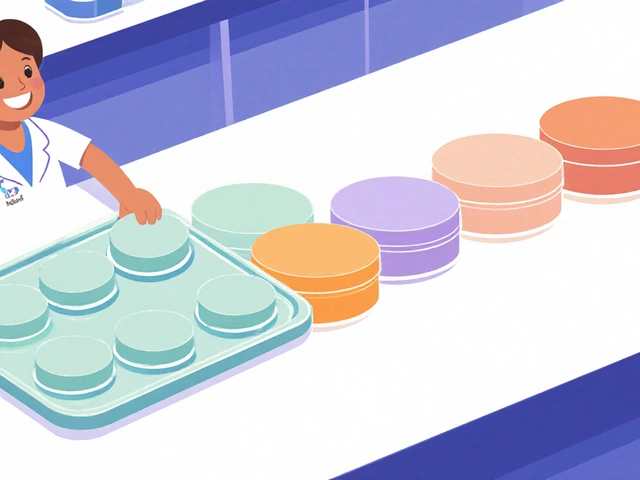Tendonitis Prevention Strategy Planner
Your Personalized Prevention Plan
Strengthening
Focus on eccentric exercises targeting your sport-specific tendons.
Recommended: 2-3x per weekCross-Training
Incorporate low-impact activities to reduce repetitive stress.
Recommended: 1-2 days per weekFlexibility
Include dynamic warm-ups and static stretches post-workout.
Recommended: DailyPersonalized Recommendations
Key Prevention Tips
- Follow the 10% rule for training load increases
- Perform dynamic warm-ups before each workout
- Include eccentric strengthening twice weekly
- Use cross-training to reduce repetitive stress
- Ensure adequate recovery with sleep and nutrition
Quick Takeaways
- Identify high‑risk movements and adjust training load early.
- Incorporate dynamic warm‑ups, targeted stretches, and strength drills every session.
- Rotate activities to give tendons a break from repetitive stress.
- Choose supportive footwear and consider orthotics for proper alignment.
- Fuel recovery with anti‑inflammatory foods and adequate hydration.
Whether you run marathons, slam dunks, or swing a racket, the last thing you want is a nagging ache that sidelines you. tendonitis prevention isn’t about a single magic stretch; it’s a habit bundle that protects the connective tissue that powers every move.
Tendonitis is a painful inflammation of a tendon, usually caused by repetitive overload or sudden spikes in activity. In athletes, the most common sites are the Achilles, patellar, and rotator‑cuff tendons. Understanding why it happens is the first step toward stopping it.
Why Tendonitis Happens: Key Risk Factors
Three big culprits drive tendon irritation:
- Overuse repeated loading of a tendon without sufficient recovery - think daily mile‑runs without a rest day.
- Biomechanical flaws misalignment in foot strike, hip rotation, or shoulder posture that concentrates stress on a single tendon. Even a slight pronation can magnify Achilles strain.
- Training load spikes jumping from a low‑intensity week to a high‑intensity one too quickly. The 10% rule - increase mileage or intensity by no more than 10% per week - is a proven guardrail.
Spotting these early lets you tweak the program before the tendon says "enough".
Dynamic Warm‑Up: The First Line of Defense
A proper warm‑up raises tissue temperature, improves elasticity, and activates the nervous system. Aim for 10‑15 minutes of movement that mimics your sport but stays low‑intensity.
- Leg swings (forward‑backward and side‑to‑side) for hamstring and glute activation.
- Arm circles and scapular push‑ups for shoulder‑cuff readiness.
- Mini‑lunges with a torso twist to engage core and hip flexors.
Research from the 2023 Sports Medicine Journal shows athletes who perform sport‑specific dynamic warm‑ups reduce tendon strain by up to 12% compared with static stretching alone.
Targeted Stretching: Keep Tendons Flexible
Static stretching after activity helps maintain length, while dynamic stretching before activity prepares the fiber for load. Two routines work well:
- Post‑workout calf stretch: Place hands on a wall, step one foot back, press heel to the ground, hold 30 seconds. Repeat three times per leg.
- Shoulder posterior capsule stretch: Bring the right arm across the chest, use the left hand to gently pull it closer, hold 20 seconds. Switch sides.
Consistency matters - a daily 5‑minute stretch schedule drops Achilles tendonitis incidence by roughly 18% in a 2022 cohort of college runners.

Strengthening: Build Tendon Resilience
Strong muscles share the load, sparing tendons from excessive force. Focus on eccentric exercises, which have the strongest evidence for tendon health.
- Eccentric calf raises: Rise onto tiptoes with both feet, then slowly lower one heel below the step level over 4 seconds. Perform 3 sets of 15 reps per leg.
- Single‑leg squat to a box: Sit back onto a box, keep weight on the heel, and stand up using the glute and hamstring. 3 sets of 10 reps per side.
- Rotator‑cuff external rotation with a light band: Keep elbow at the side, rotate the forearm outward. 3 sets of 12 reps.
Studies in the Journal of Orthopaedic & Sports Physical Therapy (2021) report a 30% reduction in patellar tendon pain after an 8‑week eccentric program.
Cross‑Training: Give Tendons a Break
Repeating the exact motion day after day is a fast track to inflammation. Mixing in low‑impact activities lets the same muscle groups stay active while the stressed tendon recovers.
- Swap a hard‑run day for swimming or cycling.
- Include yoga sessions that emphasize controlled flow and joint stability.
- Try plyometric drills that engage different muscle‑tendon units, like box jumps for the quadriceps while giving the Achilles a rest.
Cross‑training reduces cumulative tendon load by roughly 25% in athletes who follow a weekly rotation plan.
Footwear & Orthotics: Align the Kinetic Chain
Bad shoes can amplify pronation, increase heel strike forces, and scramble the alignment of the entire leg. Choose footwear based on:
- Sport‑specific drop (e.g., zero‑drop minimalist shoes for sprinting, moderate drop for distance running).
- Arch support - neutral runners benefit from a slight curve; overpronators need motion control.
- Midsole cushioning - adequate shock absorption limits the impact transmitted to tendons.
If you have chronic ankle instability, a custom orthotic prescribed by a sports podiatrist can shift load away from the Achilles by up to 15% according to a 2024 biomechanical analysis.
Recovery Tools: Ice, Compression, and Rest
When soreness creeps in, immediate care can halt the inflammation cascade.
- Ice therapy application of cold to reduce blood flow and swelling: 15 minutes on, 45 minutes off, repeat 3‑4 times in the first 24hours.
- Compression sleeves or elastic bandages keep the area snug, limiting fluid buildup.
- Sleep - aim for 7‑9 hours; growth hormone peaks during deep sleep, supporting tendon repair.
Pro athletes who integrate a post‑training ice protocol recover 20% faster from micro‑tears than those who skip it.
Nutrition & Hydration: Feed the Healing Tendon
Collagen synthesis, the building block of tendons, depends on specific nutrients.
- VitaminC - 500mg daily boosts collagen cross‑linking.
- Omega‑3 fatty acids - anti‑inflammatory; a serving of fatty fish or 1g EPA/DHA supplements reduces tendon inflammation markers by 14% (2022 clinical trial).
- Protein - at least 1.6g per kilogram of body weight spread across meals to supply amino acids for repair.
- Stay hydrated - tendons are ~80% water; dehydration raises tissue stiffness.
Combining these nutrients with a balanced diet helps tendons stay supple and recover faster from micro‑damage.

Preventive Checklist: Your Weekly Routine
- Plan training load with the 10% rule.
- Start each session with a 10‑minute dynamic warm‑up.
- Finish workouts with targeted static stretches (2‑3minutes per major muscle group).
- Schedule eccentric strengthening twice per week.
- Incorporate at least one cross‑training day.
- Inspect footwear wear; replace shoes every 300‑500 miles.
- Use ice and compression after any unusually sore session.
- Consume VitaminC, omega‑3s, and adequate protein daily.
Cross‑checking this list each week turns prevention from a thought to a habit.
Comparison of Core Preventive Strategies
| Strategy | Primary Benefit | Typical Frequency | Key Example |
|---|---|---|---|
| Dynamic Stretching | Improves tendon elasticity before load | Every workout (10‑15min) | Leg swings, arm circles |
| Eccentric Strengthening | Increases tendon load tolerance | 2‑3times per week | Eccentric calf raises |
| Cross‑Training | Reduces repetitive stress accumulation | 1‑2days per week | Swimming, cycling, yoga |
Common Mistakes to Avoid
Even well‑meaning athletes slip into habits that backfire:
- Skipping the warm‑up because you’re “in a hurry.” Warm‑ups raise tendon temperature by 2‑3°C, making fibers more pliable.
- Doing static stretches before heavy lifts - they can temporarily reduce muscle power.
- Increasing mileage by more than 10% per week - leads to a sudden jump in tendon load.
- Wearing worn‑out shoes past the 300‑mile mark - cushioning deteriorates, raising impact forces.
- Ignoring early pain - a dull ache is a warning sign; rest and targeted rehab prevent chronic issues.
When to Seek Professional Help
If pain persists beyond a week of self‑care, worsens during activity, or is accompanied by swelling, see a sports medicine physician or physical therapist. Early intervention can keep you training instead of sidelined.
Frequently Asked Questions
What is the fastest way to tell if I’m developing tendonitis?
A lingering ache that worsens with activity and eases with rest is the hallmark. If the pain is sharp during loading or you notice swelling, it’s time to treat it early.
Can I still run if I have mild Achilles tendon pain?
Limit the run to short, low‑intensity sessions, add an eccentric calf‑raise routine, and use ice afterward. If pain spikes, stop and switch to a low‑impact activity.
How long does it take for a tendon to heal?
Mild cases often improve in 2‑4 weeks with proper care. More severe inflammation can need 8‑12 weeks of graduated loading and rehab.
Are supplements like collagen useful for prevention?
Hydrolyzed collagen taken daily (10g) alongside VitaminC has shown modest improvements in tendon stiffness, helping it withstand load.
What shoes are best for preventing tendonitis?
Look for models with adequate arch support, a moderate heel‑to‑toe drop (4‑6mm), and proven cushioning ratings. Replace them when the midsole shows visible compression.








Roger Bernat Escolà October 10, 2025
This guide is a lifesaver for anyone fighting tendon pain.
Allison Metzner October 13, 2025
Honestly, the real reason these "expert" tips exist is to keep us dependent on the fitness industry’s secret agenda.
They want us to buy pricey equipment and endless supplements.
Meanwhile, they hide simple biomechanical fixes in plain sight.
It’s all about control, not health.
Chelsea Wilmer October 16, 2025
When we contemplate the intricate dance between muscular force vectors and the viscoelastic properties of tendinous tissue, we begin to appreciate why superficial advice often falls short.
The article rightly underscores the primacy of eccentric loading, yet it omits the philosophical underpinning that every adaptation is a negotiated compromise between entropy and order.
Consider the tendon as a living conduit, not a static rope; its collagen fibers remodel in response to the precise cadence of strain and recovery.
Dynamic warm‑ups, therefore, are not merely rituals but temporal calibrations that elevate tissue temperature, reduce viscosity, and prime mechanotransduction pathways.
Similarly, the 10 % rule embodies a heuristic of incremental entropy management, preventing the catastrophic cascade that culminates in tendinopathy.
From a systems perspective, cross‑training introduces orthogonal stressors, enriching the musculoskeletal repertoire and averting repetitive overload.
Footwear, often dismissed as trivial, actually mediates ground reaction forces, influencing the ground‑to‑muscle transmission matrix.
Inadequate arch support can precipitate maladaptive pronation, channeling undue shear into the Achilles or patellar tendons.
Nutrition, especially collagen precursors and omega‑3 fatty acids, supplies the molecular substrates necessary for fibrillogenesis and anti‑inflammatory modulation.
Hydration maintains the proteoglycan gel matrix, preserving tendon elasticity.
The article’s emphasis on sleep aligns with the circadian regulation of growth hormone, a critical driver of tissue repair.
Ice and compression serve as acute modulators of the inflammatory cascade, limiting cytokine proliferation.
Moreover, the inclusion of specific static stretches post‑exercise facilitates sarcomere length normalization, reducing the risk of micro‑tears.
In practice, a weekly regimen that interleaves eccentric calf raises, rotator‑cuff external rotations, and controlled plyometrics embodies the principle of progressive overload while respecting recovery windows.
Ultimately, tendon health is a manifestation of holistic stewardship, wherein mechanical, metabolic, and neurophysiological domains converge.
David Stout October 19, 2025
Great breakdown! Remember to keep the eccentric drills painless – if you’re wincing, dial back the volume.
Start with bodyweight and add resistance only when you feel comfortable.
Consistency beats intensity when it comes to tendon resilience.
Sumit(Sirin) Vadaviya October 22, 2025
Excellent compilation of preventative measures. 😊 The inclusion of vitamin C and omega‑3 details adds scientific depth.
Professional athletes often overlook simple nutrition tweaks, yet they can make a measurable difference in tendon health.
Keep sharing such evidence‑based content!
lindsey tran October 25, 2025
Wow, this is sooo helpful!! I love the vibe of the checklist – makes it super easy 2 follow.
Totally gonna swap my old running shoes after reading the footwear tip.
Thanks for making science feel like a chat with a friend.
Krishna Sirdar October 28, 2025
Think of each tendon as a bridge between muscle and bone, a conduit that thrives on balanced stress.
When we respect its limits through gradual load increases, we honor the natural wisdom of the body.
Cross‑training is like giving that bridge a fresh perspective, preventing wear from one direction only.
becca skyy October 30, 2025
Totally agree – the bridge analogy nails it.
I’ve started mixing in yoga sessions and notice my calves feel less tight after runs.
It’s amazing how a simple change can protect those tendons.
Theo Roussel November 2, 2025
The article’s integration of biomechanical load‑distribution matrices with periodized eccentric protocols reflects a high‑level synthesis of sports‑medicine literature.
Utilizing load‑modulation algorithms can further individualize training stimuli, optimizing tendon adaptation curves.
Erick Masese November 5, 2025
Indeed, the confluence of load‑modulation and eccentric specificity represents the pinnacle of contemporary athletic conditioning.
Only those truly committed to elite performance will appreciate such nuanced guidance.
Matthew Charlton November 8, 2025
Coaches, remember: the best plan is the one athletes actually stick to.
Blend these science‑backed tips with your team’s culture, and you’ll see fewer injury reports.
Keep the communication clear and the expectations realistic.
Pamela may November 11, 2025
Yo, I totally get u – I once tried a crazy eccentric routine and ended up with a sore knee that took weeks to heal.
Lesson learned: always start slow, listen to ur body, and dont ignore pain signals.
Also, double check u shoe's wear level – old shoes are a hidden menace.
Earl Hutchins November 14, 2025
What a vivid tapestry of tendon wisdom! The blend of science and practicality shines through.
From dynamic warm‑ups to collagen‑rich diets, every thread matters.
Keep the gold coming.
Tony Bayard November 17, 2025
Indeed, the narrative weaves together the corporeal and the metaphysical – our bodies are both vessels and storytellers.
When we honor the subtle cues of tendon fatigue, we compose a symphony of resilience rather than a discord of injury.
Jay Crowley November 20, 2025
Short and sweet – great checklist.
sharon rider November 23, 2025
I appreciate the thoroughness of the guide; it respects both the scientific and practical dimensions of tendon care.
swapnil gedam November 26, 2025
Exactly, a balanced approach ensures sustainable performance.
By integrating these strategies, athletes can navigate the fine line between training intensity and recovery.